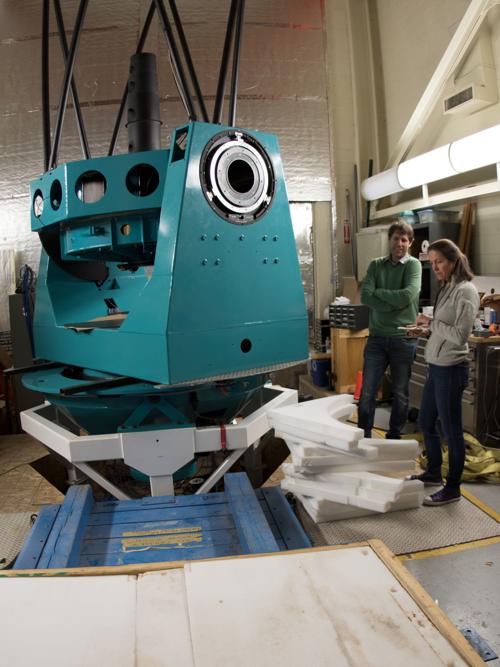The Calypso telescope, once the only privately owned telescope atop Kitt Peak, will begin its journey to its new home on Chile’s Cerro Pachón mountain soon.
There, it will be used as a calibration telescope for the Large Synoptic Survey Telescope — a new generation of telescope headquartered on the University of Arizona campus — that will scan the sky nightly for 10 years to produce a 3-D movie of the universe.
Calypso was donated to the LSST in 2008. In 2014, it was removed from the Kitt Peak observatory southwest of Tucson and placed in storage at the UA.
Since then, it has undergone a makeover in preparation for its move and new mission, including a new paint job to match the LSST.
“It’s old,” said Patrick Ingraham, calibration hardware scientist for the LSST, “and it ran using electronics you can’t even get anymore.” The telescope’s updated electronics will be managed by new software.
The LSST will capture images of the sky more than 40 times the area of the full moon at a time while Calypso focuses on a single star within the LSST field of view and records how the incoming light from the star is distorted by the atmosphere.
“Using that data, we can measure things like water and aerosols, which are things like sea salts and dust” and volcanic ash, Ingraham said. “We can use that to essentially remove its effect from LSST data.”
Calypso is being shipped Thursday, but it will not be looking at the sky right away, he said. The goal is to have Calypso ready for a year before LSST collects its first light around 2020.
“Understanding the atmosphere is one of our key limitations right now,” Ingraham said. Working ahead of time will let LSST astronomers anticipate atmospheric variations caused by seasons.
Without an accurate Calypso, cutting-edge astronomy would be much more difficult.
For example, astronomers precisely measure the brightness of supernovas — the explosive deaths of some stars — to determine the distance of certain galaxies. A certain class of these explosions generates a predictable amount of light.
If an explosion looks dimmer than what’s expected, astronomers can infer that it occurred within a galaxy far away, in the same way that car headlights look dimmer the farther away they are. Conversely, a brighter explosion occurred closer by.
An uncorrected, turbulent atmosphere would disrupt these accurate measurements, which can be used to determine the expansion rate of the universe and reveal the mysterious physics of dark energy, which is thought to be driving that expansion.
Despite this, if Calypso were to break down, the LSST would have to continue its scanning of the sky. It would still be able to observe some kinds of light that can pass unfettered by the earth’s atmosphere.





